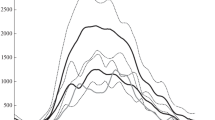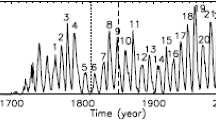Abstract
The characteristics and course of development of the current 24th solar activity (SA) cycle allow it to be considered a cycles in an epoch of lowered SA. Comparison of evolutionary changes in the cycles of different epochs in the phases of the minimum made it possible to distinguish two groups by the rate of decline. The first group with a relatively fast decline (~15 months) includes all cycles of epochs of increased SA, transition periods, and cycle 16 from the epoch of lowered SA. The second, with a slow decline (~40 months), contains the rest of the cycles of epochs of lowered SA, including the current 24th one, the minimum of which can be expected in the first half of 2020.



Similar content being viewed by others
REFERENCES
Ishkov, V.N. and Shibaev, I.G., Solar activity cycles: General characteristics and modern forecasting boundaries, Bull. Russ. Acad. Sci.: Phys., 2006, vol. 70, no. 10, pp. 1643–1647.
Shibaev, I. and Ishkov, V., Investigation of the statistical characteristics of Wolf numbers reliable series: Signs of solar cycles likelihood, in 7th Scientific Conf. “Space, Ecology, and Safety” (SES-2011), Sofia, 2012, p. 297.
Ishkov, V.N., Solar sunspot-forming activity and its development on the reliable Wolf numbers series. Variability of the Sun and Sun-like stars: from astroseismology to space weather, in EDP Sciences Proceedings, 2018, pp. 109–118. https://international.scholarvox. com/catalog/book/88855582?_locale=en.
Ishkov, V.N., Space weather and specific features of the development of current solar cycle, Geomagn. Aeron. (Engl. Transl.), 2018, vol. 58, no. 6, pp. 753–767. https://doi.org/10.1134/S0016793218060051
Otkidychev, P.A. and Skorbezh, N.N., Specific features of solar activity cycle 24 and their link with general regularities of cycles 19–23, in Trudy Pulkovskoi konf. “Solnechnaya i solnechno–zemnaya fizika-2013” (Proceedings of the Pulkovo Conference “Solar and Solar–Terrestrial Physics-2013”), St. Petersburg: VVM, 2013, pp. 187–190.
Heinemann, S.G., Temmer, M., Heinemann, N., et al., Statistical analysis and catalog of non-polar coronal holes covering the SDO-Era using CATCH, Sol. Phys., 2019, vol. 294, id 144. https://doi.org/10.1007/s11207-019-1539-y
Yang, S., Zhang, J., Zhu, X., and Song, Q., Block-induced complex structures building the flare-productive solar active region 12673, Astrophys. J. Lett., 2017, vol. 849, id L21. https://doi.org/10.3847/2041-8213/aa9476
Carrasco, V., Vaquero, J., and Gallego, M., Analysing spotless days as predictors of solar activity from the new sunspot number, Sol. Phys., 2017, vol. 292, id 154. https://doi.org/10.1007/s11207-017-1172-6
Wilson, R. and Hathaway, D., On the relationship between spotless days and the sunspot cycle: A supplement, NASA/TP-2006-214601. https://ntrs.nasa.gov/ search.jsp?R=20070018264 2020-03-09T15:04:17+00:00Z.
Author information
Authors and Affiliations
Corresponding author
Rights and permissions
About this article
Cite this article
Ishkov, V.N. The Current 24th Cycle of Solar Activity in the Minimum Phase: Preliminary Results and Features of Development. Cosmic Res 58, 436–443 (2020). https://doi.org/10.1134/S0010952520060064
Received:
Revised:
Accepted:
Published:
Issue Date:
DOI: https://doi.org/10.1134/S0010952520060064




